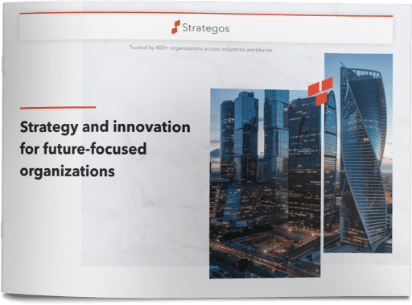Framing innovation challenges is of critical importance when leadership decides to engage their employees in innovation activities. Crowdsourcing ideas is a popular, energizing way to solve a wide range of business problems. With the availability of many online idea management platforms engaging a greater number of employees has become much easier and effective.
The business problem is presented as an innovation challenge to a large audience in order to gain diverse perspectives and approaches. External or internal participants can comprise the audience. Strategos’ clients, almost exclusively, start with running internal challenges. Our work over the years in a variety of industries has shown that those closest to the work and the customers have the best insights to improve performance, reduce cost, or develop new products and services. Since we leverage the front line workers, we call our version of internal crowdsourcing “front line challenges”.
The objective of front line innovation challenges is to implement change within the organization; change that bubbles up from internal innovators. When framing innovation challenges leadership must aim them at an area that will have impact on customers and the business while engaging the energy and creativity of the front line organization. Aiming or focusing innovation on issues of importance is accomplished by presenting a compelling challenge statement.
How do we go about framing innovation challenges?
- A great challenge statement resonates with the organization and draws in participants.
- A great challenge statement promotes dialogue and collaboration in the organization.
- A great challenge statement generates good surprises so that leadership says, “Oh, I never saw it that way”.
Let’s see how this works in the following example.
A quick service restaurant chain has recently had some findings from local health departments. To address this issue, leadership proposes the following innovation challenge: “How can we increase compliance with hand-washing standards?” While this would certainly solicit useable ideas, participation is probably going to be low because it’s an inward looking compliance approach, it’s mildly accusatory and it’s a chore. Minimizing violations is not inspirational for a challenge.
The real concern is food safety so a better way of framing the innovation challenge is “What changes do you suggest in order to make our restaurants outstanding for cleanliness?”
Now let’s parse it…
| What changes | Asking for “changes” removes any tinges of recrimination. This also immediately opens up the possibility of new-new solutions not just compliance with existing processes. |
| do you suggest | Emphasizing ownership of the idea is the essential appeal of the challenge. Don’t hide it under language that is too soft like “How might we…” |
| in order to make | Working in the objective and aspiration of the challenge is also an essential component of a great challenge statement. Address the first question any participant will ask “Why are we doing this?” |
| our restaurants | Framing “our restaurants” is a simple but important signal to employees of inclusiveness and community. |
| outstanding | Broadening the scope beyond compliance with internal standards or local health codes will yield divergent responses and may even apply useful examples that are outside of the industry. |
| for cleanliness | Again, intentionally broadening the scope so that everything is in play from fixtures to handling to preparation to disposal will elicit more ideas |
With a broader challenge statement, the organization will receive a broader set of meaningful actions: eliminating plastic trays, adding biodegradable utensils, adding prep stations in common work areas, minimizing wait-time for supplier deliveries through a new process, and rewarding customers for bussing their own tables.
When framing innovation challenges, don’t fall into the trap of mission statement writing with endless wordsmithing and long run on sentences. Limit yourself to two meetings for crafting the statement and then launch the challenge. Model agile behavior by getting started and learning from your results.
The objective of aiming with a great challenge statement is to focus and inspire the front line of the organization. You need both to succeed. Success is both engagement that unlocks the capabilities of your talent pool and stimulates ideas leading to actions that will make a difference to your customers.
For more useful advice on running successful and effective innovation challenges please read: Everyone’s an innovator




